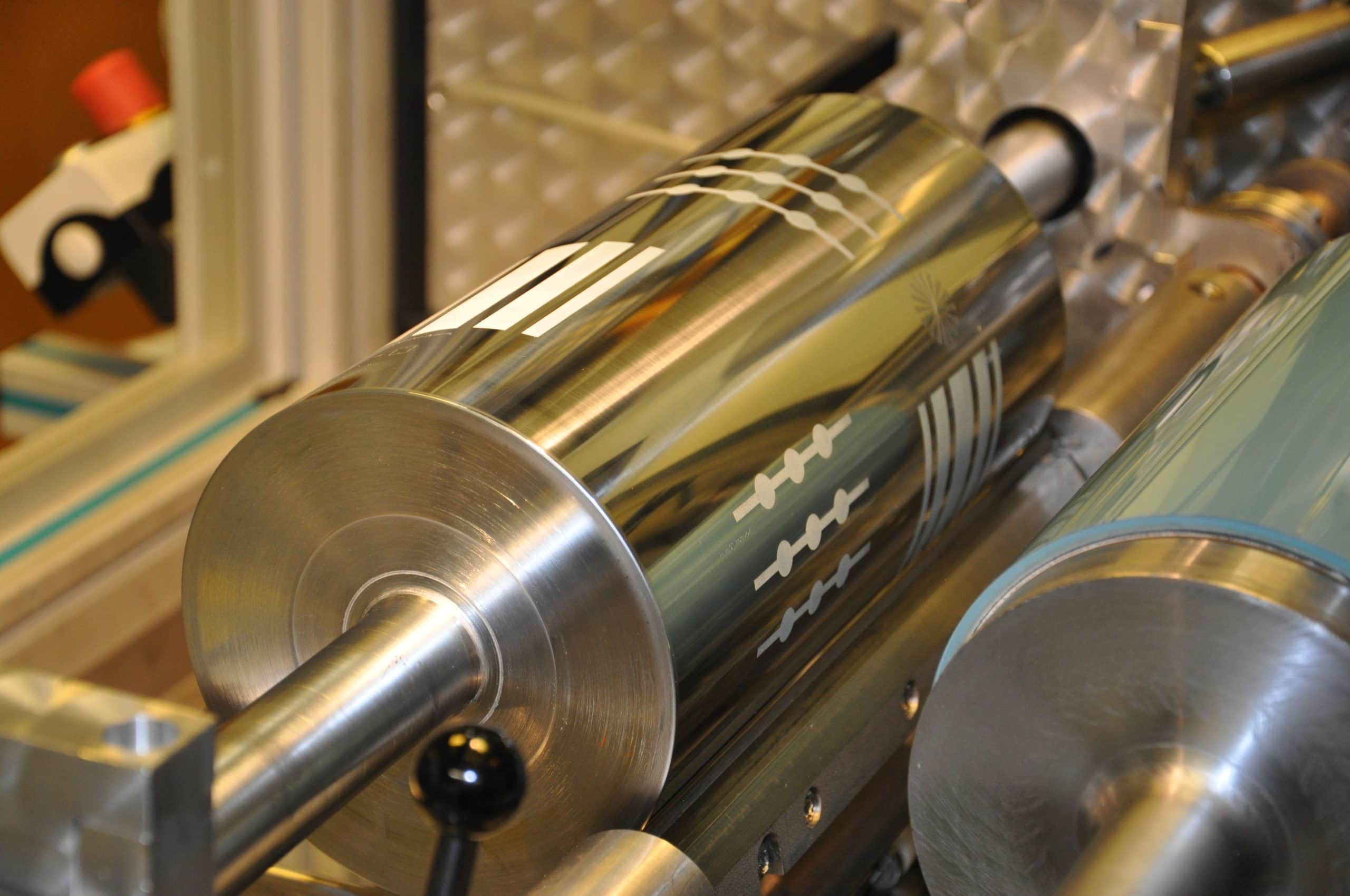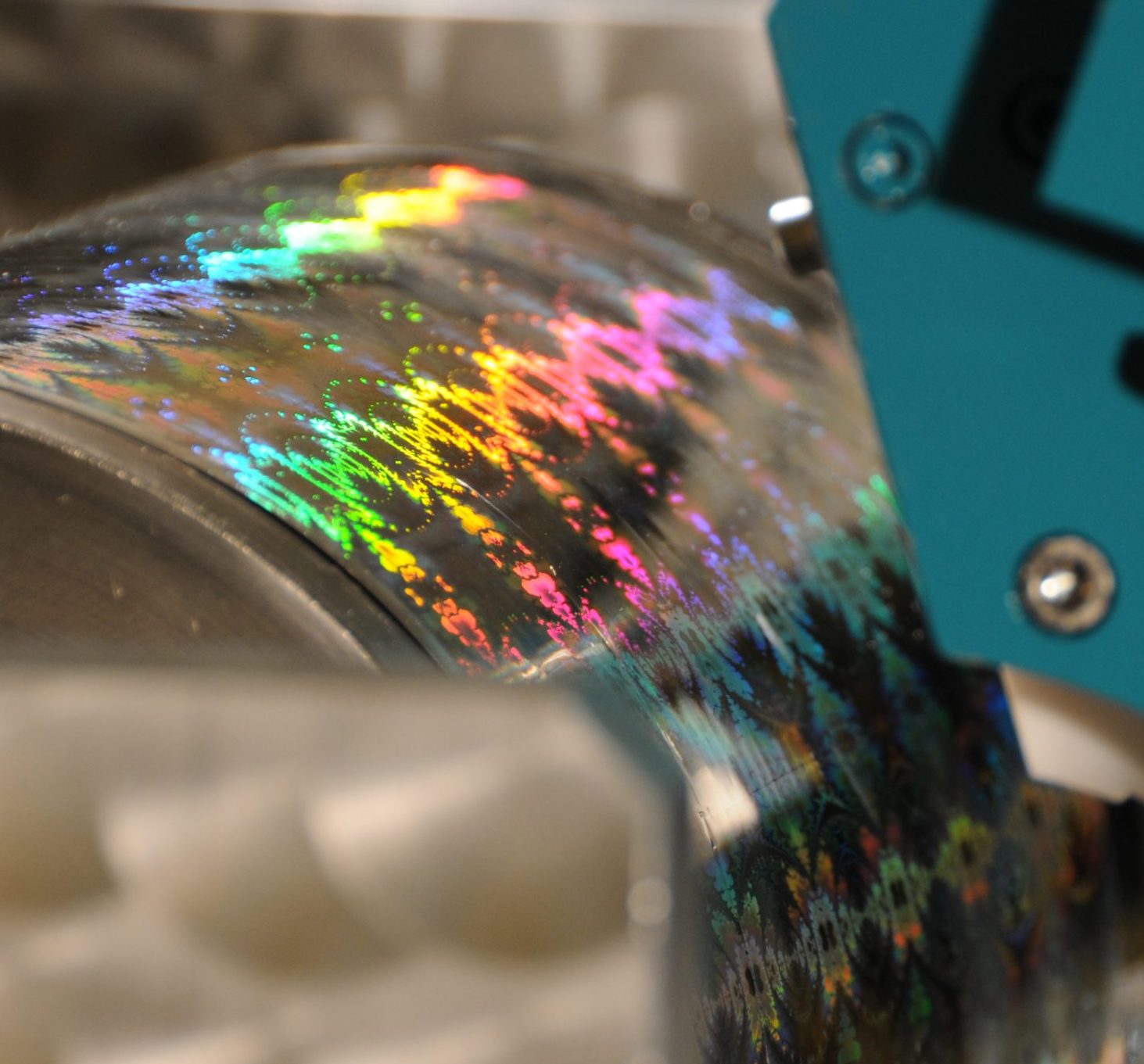- About us
- Research expertise
- DIGITAL – Institut für Digitale Technologien
- MATERIALS – Institut für Sensorik, Photonik und Fertigungstechnologien
- ROBOTICS – Institut für Robotik und Flexible Produktion
- COREMED – Zentrum für Regenerative Medizin und Präzisionsmedizin
- HEALTH – Institut für Biomedizinische Forschung und Technologien
- LIFE – Institut für Klima, Energiesysteme und Gesellschaft
- POLICIES – Institut für Wirtschafts-, Sozial und Innovationsforschung
- Business areas
- Products & services
- Research infrastructure
- Beteiligungen
- Career
- Aktuelles
- Publications
- Kontakt zu uns
Roll-to-roll nanoimprint lithography
Our R2R-UV-NIL pilot line enables the continuous and cost-effective production of micro and nanostructures on flexible large-area film substrates for applications in lighting, photovoltaics, AR/VR, AR/VR, microfluidics, diagnostics, security, film finishing and packaging, the pharmaceutical industry and life sciences.

Roll2Roll system, credit: JOANNEUM RESEARCH/Bergmann
Nano-structures in roll-to-roll
The R2R pilot plant enables us to:
- sustainable production of high-resolution conductive structural elements for organic electronics (fine conductor tracks, nanoscale electrodes for organic transistors)
- precise optical creation of 2.5D structures for the light management in flexible films (coupling and outcoupling, light guiding) for applications in photonics
- large-scale realisation of structured bionic surfaces and complex nanopatterns, which allow the artificial imitation of biological characteristics (shark skin, lotus effectgecko effect, structural colors)
- cost-effective production of complex microfluidic elements on foil for bioanalytic lab-on-foil systems
- continuous production of optimized high-tech film surfaces for packaging, decoration, safety and labeling, which display improved optical, mechanical and chemical behavior due to their micro and nanostructural properties
You are currently viewing a placeholder content from Youtube. To access the actual content, click the button below. Please note that doing so will share data with third-party providers.
Process sequence for R2R imprinting
- The entire system is located inside a laminar flow box, which guarantees a class 10.000 cleanroom environment (ISO 7 standard).
- A flexible polymer film as substrate on a roll is cleaned from particles by means of ionization and suctioning devices during the production process. If necessary, the surface to be coated may be pre-treated in a corona unit to improve wettability.
- The web edge control after unwinding and directly before winding regulates the position of the web edge, keeps the web centred and ensures even winding.
- A coating step follows, whereby the liquid lacquer is applied by means of gravure printing. If necessary, the material can then be pre-dried in the thermal dryer in order to evaporate undesired solvent.
- The structuring of the coated embossing varnish is then carried out using UV nanoimprint lithography (UV-NIL). The structures are transferred from an embossing die into the still liquid UV-curable lacquer and cured/cross-linked by means of UV exposure. Once these structures on the film have been released from the embossing stamp, the film is rewound.
- The quality of the embossing is checked in-line with a high-resolution line scan camera.
Find out more about our services in the area of R2R pilot line for micro- and nanostructuring as well as Materials and components for micro- and nanostructuring (NILcure®).

Your contact
Location
Das sagen unsere Kunden
Further research infrastructure
We use a specially modified EVG770 Nanoimprint Lithography (NIL) stepper for the large-scale production of micro- and nanostructures in UV imprint resins. Together with special materials and processes, we achieve the highest precision right down to practically seamless transitions between individual structures.
Certified class 6 cleanroom for nanostructures and innovative electronic components and sensors
Microassembly Lab for photonic and electronic assemblies
This highly precise maskless laser system (MALA) is suitable for the production of highly complex and stepless micro-optical structures.
The lab includes flexible, rapid prototyping processes to produce a variety of structures in a wide range of materials.
We offer laser material processing and many years of expertise in materials science.
State-of-the-art development infrastructure for integrated electronic and optical design including EMC and ESD - open to industrial partners.
State-of-the-art infrastructure for light measurement and prototype production for integrated optical and electronic design - open to industrial partners.
Our laboratory includes technologies for functional plasma coating at low temperatures from atmospheric pressure to fine and high vacuum.
Printing technologies for the development of customised 2D, 2.5D and 3D printing processes
Measurement and analysis of the smallest structures, layers and components on a micro- and nanometre scale
SHAPING THE FUTURE, TOGETHER
JOANNEUM RESEARCH provides innovation and technology services in the field of applied research. As a research company working on behalf of various federal provinces and regions in Austria, our expertise shapes the development of our modern society and economy – sustainably, and always with a focus on people. As a multidisciplinary team working in a flexible set-up that fosters innovation, we always live up to the highest social and scientific standards.







